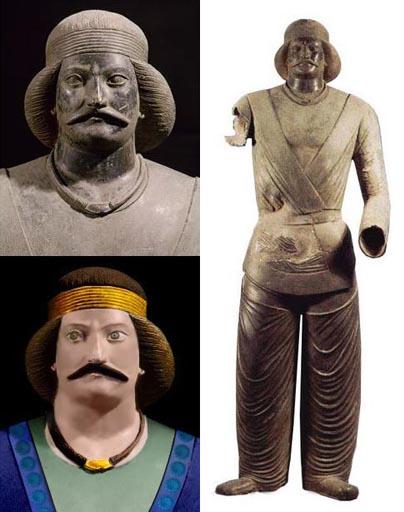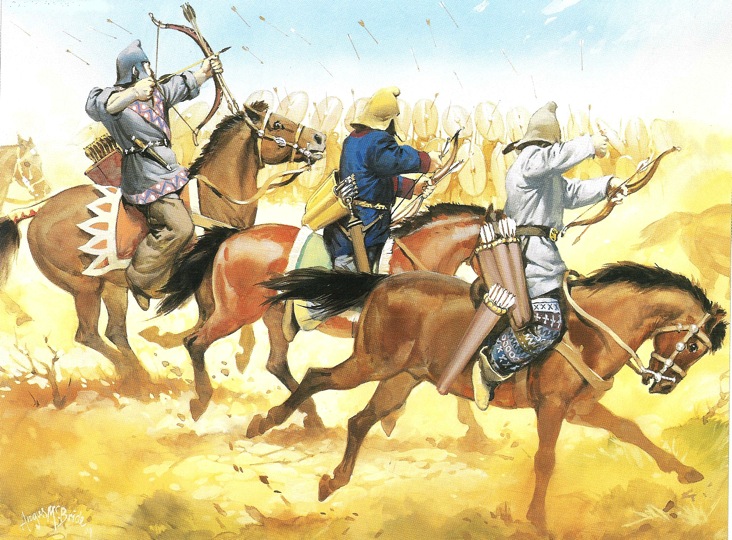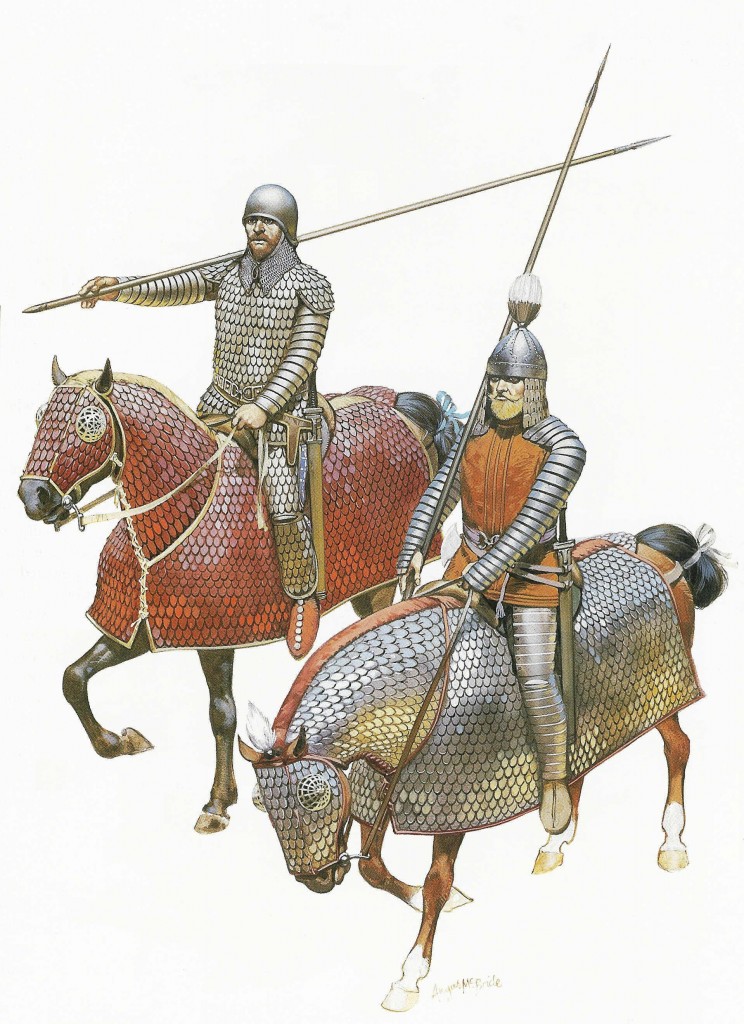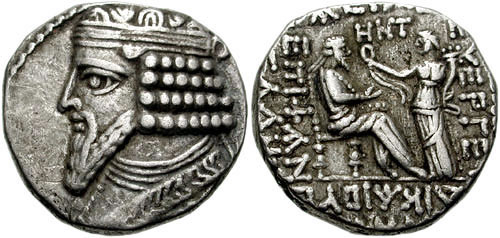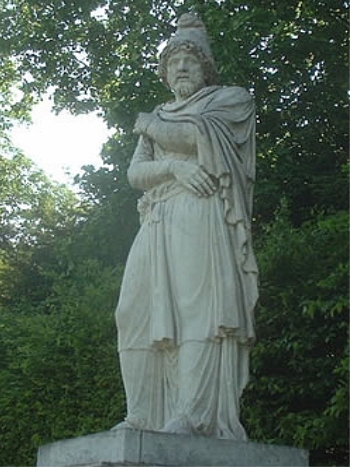The article below on the Arsacid Dynasty of the Parthians is authored by Klaus Schippmann and was originally posted in the Encyclopedia Iranica.
Kindly note that the pictures/illustrations inserted below do not appear in the original Encyclopedia Iranica posting.
For readers of Parthian military history, a monograph-booklet has been published (2016) in Persian (with an English section) on the structure of the Parthian army by Kaveh Farrokh (University of British Columbia-Continuing Studies) and Gholamreza Karamian (Tehran Azad University-Central Branch, History and Archaeology Department):
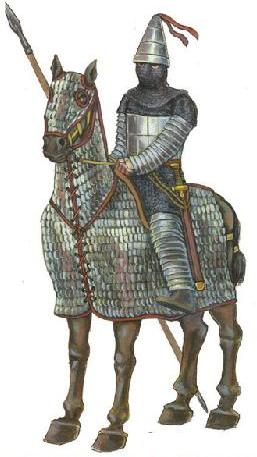
Parthian armored lancer (Picture Source: Civilization Fanatics Center).
========================================================================
The rise of the Arsacids is closely linked to the history of another dynasty, that of the Seleucids (q.v.). After 308 B.C. its founder, Seleucus I, had conquered the eastern part of Iran and also, after the battle of Ipsus (301 B.C.), annexed large portions of Syria. In the following decades the Seleucids were mostly to concentrate their interest and their power on the western half of their vast kingdom, particularly as a result of their struggles against the Lagids for dominance in Syria. This led to the Seleucids losing large parts of their Iranian possessions within a period of roughly fifteen years from 250 to 235 B.C. (Although there is some dispute amongst historians as to the chronological sequence of events, it is at least agreed that they occurred within this span of time.)
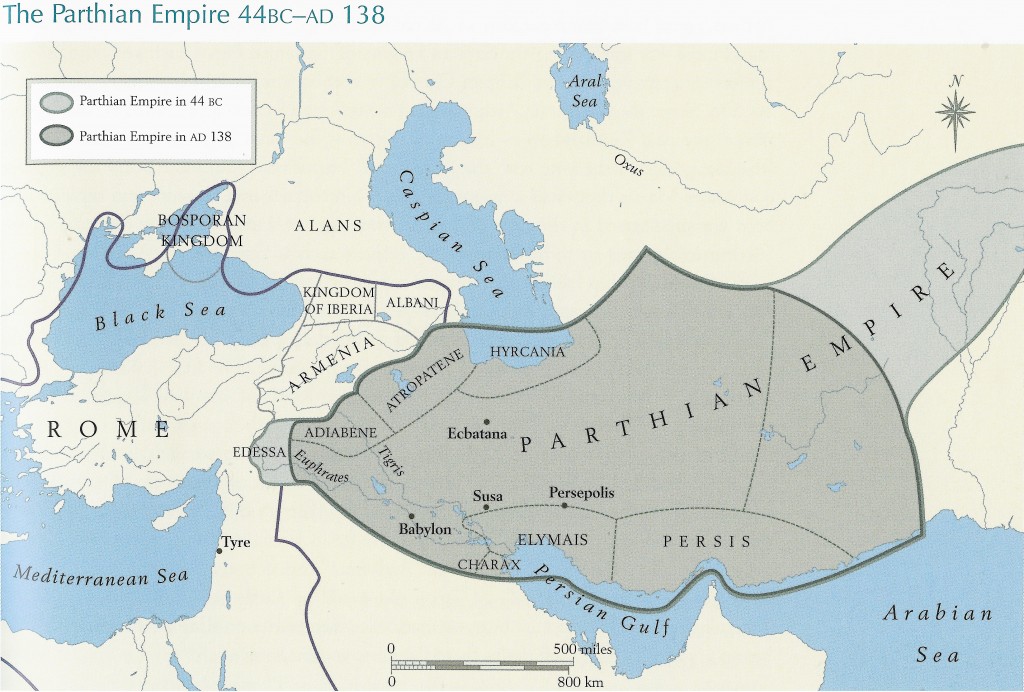 Map of the Parthian Empire in 44 BCE to 138 CE (Picture source: Farrokh, 2007, page 155, Shadows in the Desert: Ancient Persia at War-Персы: Армия великих царей-سایههای صحرا–).
Map of the Parthian Empire in 44 BCE to 138 CE (Picture source: Farrokh, 2007, page 155, Shadows in the Desert: Ancient Persia at War-Персы: Армия великих царей-سایههای صحرا–).
The most important role during this period was played by the Parni, an Iranian tribe belonging to the Dahae who, according to the ancient writers (Arrian, Anabasis 3.28.8, 10; Quintus Curtius 8.1.8) lived in the territories between the Oxus and the Jaxartes at the time of Alexander the Great. About the end of the fourth or at the latest by the middle of the third century B.C. the Parni had advanced as far as the frontiers of the Seleucid kingdom, whether in the vicinity of the Caspian Sea or on the river Tejen (Turkmenistan). The movements of the Parni and Dahae, beginning in the area between the Oxus and the Jaxartes and ending in the immediate vicinity of the Seleucid satrapy of Parthava, are difficult to reconstruct and therefore a matter of dispute among historians. (cf. K. Schippmann, Grundzüge der parthischen Geschichte, Darmstadt, 1980, pp. 15ff.)
Around 250 B.C. at any rate, the Parni, under their leader Arsaces, penetrated into the Astauene, that is to say probably into the territory along the Atrek valley. (See however also I. N. Chlopin, Iranica Antiqua 12, 1977, pp. 143ff.) Shortly afterwards, probably ca. 247 B.C., Arsaces was proclaimed king in Asaak, the exact location of which has still to be identified. This event, it is widely assumed, marks the beginning of the Arsacid era. (See most recently P. H. L. Eggermont, Bibliotheca Orientalis 32, 1975, pp. 15ff.)
In about 245 B.C., during the reign of the Seleucid monarch Seleucus II (r. 246-25 B.C.), Andragoras, the Seleucid satrap of the province of Parthava, made himself independent. Soon afterwards, ca. 239 B.C., his example was followed by Diodotus, satrap of Bactria, a Seleucid satrapy which was to play a significant role for more than a hundred years as the Greco-Bactrian kingdom.
The reasons for the defection of these two satrapies in such rapid succession are not known, nor is the extent to which the inhabitants, i.e. Macedonians, Greeks, and the natives, participated in the rebellions (cf. E. Will, Histoire politique du monde hellénistique
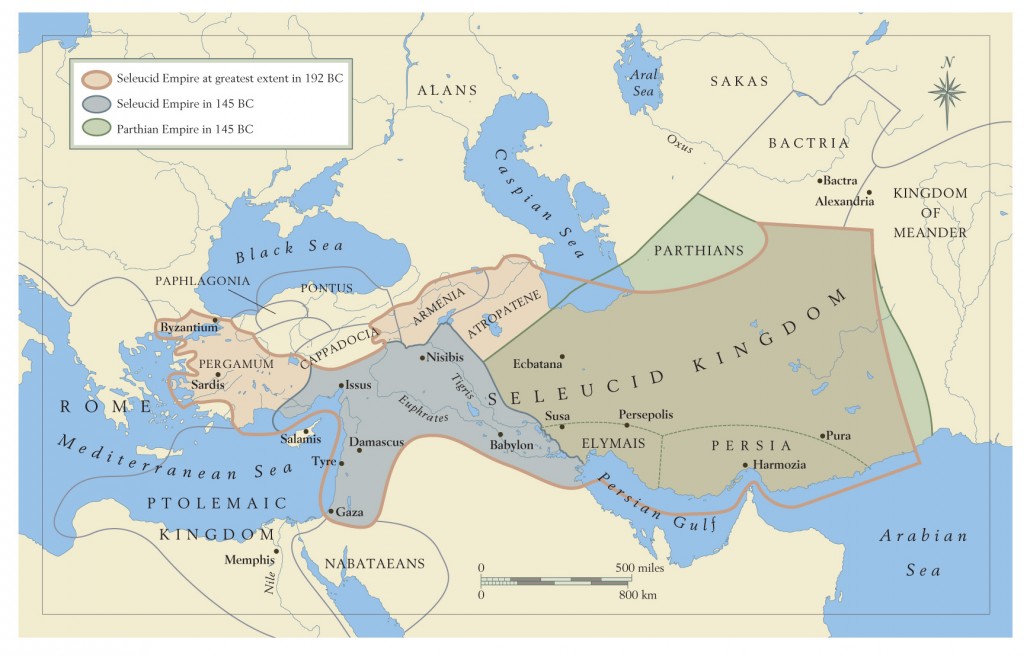 Parthia and the Seleucid kingdom in circa 145 BCE (Picture source: Farrokh, 2007, page 119, Shadows in the Desert: Ancient Persia at War-Персы: Армия великих царей-سایههای صحرا–).
Parthia and the Seleucid kingdom in circa 145 BCE (Picture source: Farrokh, 2007, page 119, Shadows in the Desert: Ancient Persia at War-Персы: Армия великих царей-سایههای صحرا–).
The Seleucids did not mount a counter-campaign in the east until the year 231-27 B.C., by which time it was already too late. Above all else it failed because unrest in Asia Minor soon forced Seleucus II to break off operations.
Fully two decades passed before the great Seleucid ruler Antiochus III made a renewed attempt, ca. 209 B.C., to regain the Parthian and Greco-Bactrian territories, but this, too, was a failure. Although he was able to register a certain degree of success, in the end the warring parties concluded treaties, according to which the Parthians and Greco-Bactrians nominally recognized the Seleucids as overlords, but the letter conceded de facto independence to the two kingdoms.
In the Parthian kingdom itself, from 217 B.C. onwards, Arsaces I had been succeeded by his son Arsaces II. (Some historians also take the view that after a reign of 2-3 years Arsaces I was replaced by his brother Tiridates, see A. D. H. Bivar in Camb. Hist. Iran III/3, 1983, p. 37.) Very little is known of events during the reign of Arsaces II or those of his successors Phriapatius (ca. 191-ca. 76 B.C.) and Phraates I (ca. 176-ca. 71 B.C.), but it is certainly true to say that their small kingdom had consolidated its position on the shores of the Caspian Sea.
The Parthian empire from Mithridates I (ca. 171-39/8) to Mithridates II (ca. 124/3-88/7 B.C.). The next ruler, Mithridates I, ushered in that great and decisive epoch in the history of his people during which Parthia rose to become a major power in the Ancient East. This Mithridates and his successors achieved in a series of campaigns against the Seleucids and later the Romans in the west, and in the east against the Greco-Bactrian kingdom and the nomadic peoples who again and again emerged from the steppes between the Oxus and the Jaxartes. More source materials are available for this period in Parthian history than for the initial phase, but the exact chronology of events is still in many ways unclear.
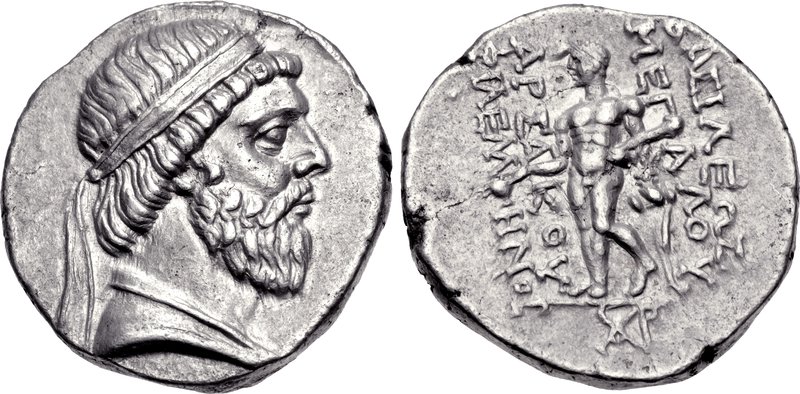 Coin of bearded Parthian monarch: the Classical Numismatic Group, Inc. and Wikipedia cite the coin as depicting Mithridates I (165-132 BCE). However as noted by Kostas Kokkoras (Κώστας Κόκκορας) the Greek inscription reads “ΒΑΣΙΛΕΩΣ ΜΕΓΑΛΟΥ ΑΡΣΑΚΟΥ ΦΙΛΕΛΛΗΝΟΣ” which translates to “Of great king Arsaces the Philhellene”.
Coin of bearded Parthian monarch: the Classical Numismatic Group, Inc. and Wikipedia cite the coin as depicting Mithridates I (165-132 BCE). However as noted by Kostas Kokkoras (Κώστας Κόκκορας) the Greek inscription reads “ΒΑΣΙΛΕΩΣ ΜΕΓΑΛΟΥ ΑΡΣΑΚΟΥ ΦΙΛΕΛΛΗΝΟΣ” which translates to “Of great king Arsaces the Philhellene”.
The first campaign of Mithridates I was probably directed against the Greco-Bactrian kingdom (between 160 and 155 B.C.) with the aim of reconquering the territories that had been lost in that region during the reign of Arsaces I, especially the area around Nisa. What is certain is that the Parthians then conquered Media in the second half of 148 B.C. (According to the Seleucid inscription of June 148 at Bīsotūn a Seleucid governor was at any rate still in office there at that point in time. Cf. L. Robert, Gnomon 35, 1963, p. 76; H. Luschey, Archäologischer Anzeiger, 1974, p. 123.) On the evidence of a cuneiform text it is also known that by 12 October 141, Mithridates’ power was recognized as far afield as the ancient Sumerian city Uruk in southern Mesopotamia. Shortly before this he had had himself crowned king in Seleucia. It is also possible that the capital was transferred to Ctesiphon as early as his reign.
Not long afterwards the Parthians were for the first but not the last time forced to defend themselves against a fierce attack by nomads, possibly the Sakas, in the east. Mithridates took personal command of the campaign, even though the Seleucids were just then making ready to reconquer Mesopotamia. Presumably he considered the adversary in the east to be the more dangerous, an assessment of the situation which subsequent events confirmed as correct. The invasion in the northeast was successfully repulsed, then the Seleucid ruler Demetrius II, after making initial gains, was taken prisoner. Shortly before his death in 139/8 B.C. Mithridates also went on to conquer Elymais.
His greatest achievement had been to make the Parthians a world power. It seems quite probable, as J. Wolski has suggested (in H. Temporini and W. Haase, eds., Aufstieg und Niedergang der römischen Welt II/9.1, Berlin, 1976, pp. 198ff.), that the western policies of the Parthian king were based on a strategy involving not only the conquest of Mesopotamia but also the subsequent overthrow of Syria in order to gain access to the Mediterranean. Certainly, the exploits of Mithridates can no longer simply be classified as a series of raids for the purpose of pillaging and capturing booty.
His son and successor, Phraates II (ca. 139/8-ca. 28 B.C.) had to face the final, fruitless attempt on the part of the Seleucids to regain their power in the east. In 130 B.C., his adversary Antiochus VII Sidetes (139/8-29 B.C.) gained fairly substantially—reconquering Babylonia and Media, but soon afterwards the inhabitants of the Seleucid garrison towns revolted and allied themselves with the Parthians. The Seleucids then suffered a crushing defeat and Antiochus VII himself met his death (on these events see Th. Fischer, Untersuchungen zum Partherkrieg Antiochus VII im Rahmen der Seleukidengeschichte, Tübingen, 1970). From this point on the Seleucid kingdom effectively ceased to be a rival for the Parthians.
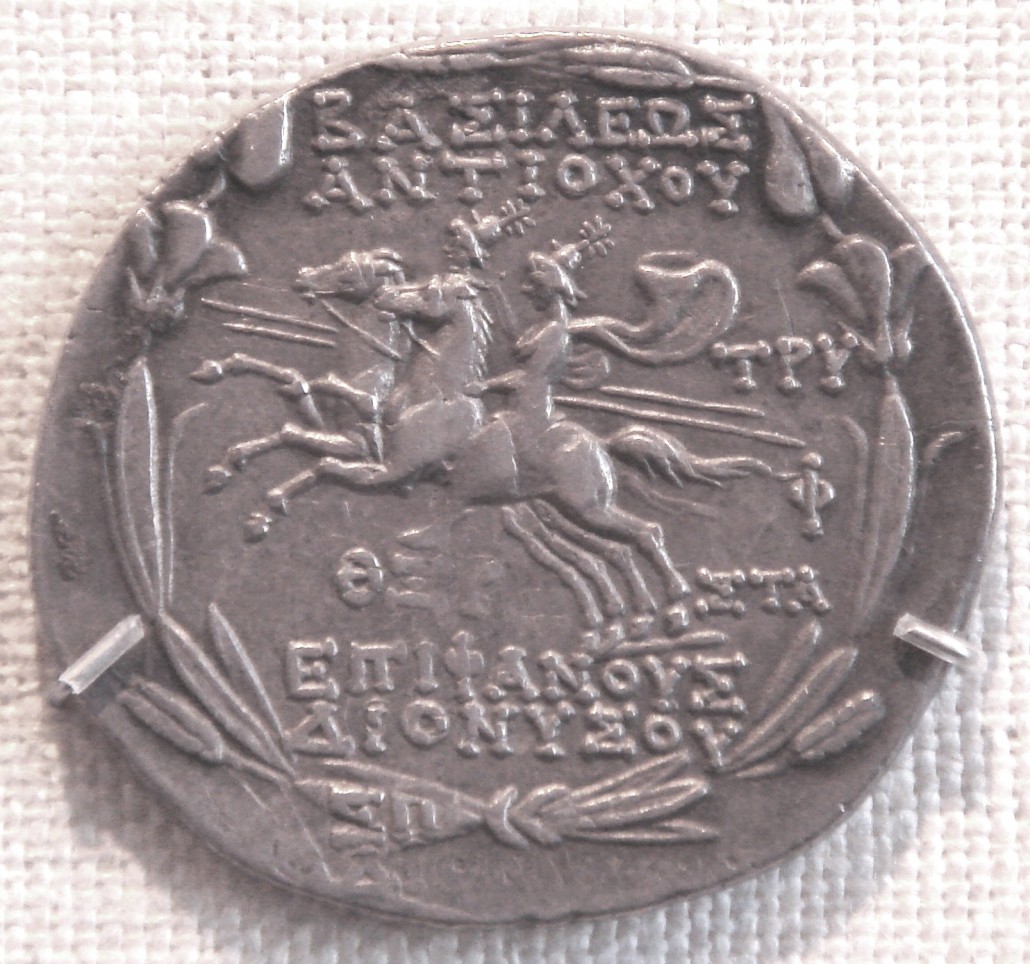 The end of the Seleucids in Persia: After initial successes against the Parthians, Antiochus VII Sidetes (138-129 BCE) (see coin above – Source: Uploadart in Public Domain) was defeated and killed by 129 CE; after this the Seleucids were to be confined for the remainder of their tenure in Syria. The Parthians were now the undisputed rulers of Iran.
The end of the Seleucids in Persia: After initial successes against the Parthians, Antiochus VII Sidetes (138-129 BCE) (see coin above – Source: Uploadart in Public Domain) was defeated and killed by 129 CE; after this the Seleucids were to be confined for the remainder of their tenure in Syria. The Parthians were now the undisputed rulers of Iran.
For their part, however, the Parthians were unable to rejoice in the victory for long because in the next few years they were again forced to come to terms with the nomads on their eastern frontier. As a result of the movements of the Huns in inner Asia various nomadic peoples began to appear in the region of the Oxus approximately during the period 133-129 B.C. The most important ones were the Yüeh-chih, who conquered the Greco-Bactrian kingdom and founded the empire of the Kushans (q.v.), the Sakas, and the Massagetae who turned against the Parthian empire. (For an account of these events, see P. Daffinà, L’immigrazione dei Saka nella Drangiane, Rome, 1967.) Both Phraates II and his successor Artabanus I (ca. 127-24/3) lost their lives in the course of these struggles. In addition to this, Hyspaosines, the ruler of the newly-founded kingdom of Characene in southern Mesopotamia, conquered fairly large parts of Mesopotamia, reaching as far up as Babylon. (For the history of this kingdom, see S. A. Nodelmann, Berytus 13, 1959-60, pp. 83ff.)
Under these difficult circumstances Mithridates II (ca. 124/3-88/7 B.C.), one of the most outstanding ruling figures of the ancient East, ascended the throne. First, he succeeded in defeating Hyspaosines (ca. 122/1), then he made the northern Mesopotamian kingdoms of Adiabene, Gordyene, and Osrhoene into vassal states, and conquered Dura-Europos in 113 B.C. Then he established contact between Parthia and Armenia (ca. 97 B.C.), deposed King Artavasdes and replaced him with his son Tigranes on the throne, in exchange for which he received “seventy valleys” (Strabo 11.14.15). The two countries were henceforth to be in virtually constant contact with one another, whether on a friendly or a hostile basis.
Mithridates II, known as “the Great” and from ca. 109/8 B.C. assuming the title “King of Kings,” also presided over events of a more peaceful nature. Around 115 B.C. he was visited by an embassy from the Chinese emperor Wu-ti, and the two rulers reached an agreement on the opening of the trade route later known as the “Silk Road.” A meeting also took place with Rome, the major world power in the West, on the Euphrates in 96 B.C. not in 92 B.C. as hitherto accepted. (E. Badian, Studies in Greek and Roman History, Oxford, 1964, pp. 157ff.; see also J. Wolski, op. cit., p. 196 n. 5. On relations between Rome and Parthia since Mithridates II see E. Dabrowa, La politique de l’état Parthe à l’égard de Rome—d’Artaban II à Vologèse I (ca. 11-ca 72 de N. E.) et les facteurs qui la conditionnaient, Cracow, 1983, pp. 15-69. The Parthian ambassador Orobazos offered Sulla, the propraetor of the province of Cilicia, the “friendship” and “alliance” of his master. Though the exact outcome of this meeting is unclear, the agreements with China and Rome prove Parthia’s rise to world status.
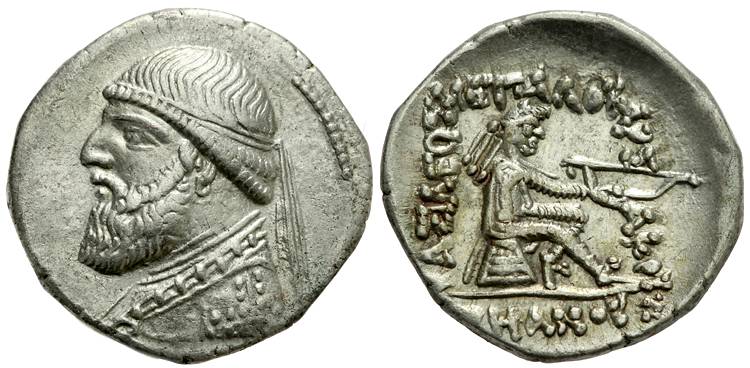 Mithradates II portrayed on Drachma coin with Hellenic influences (Source: Dynamosquito in Public Domain).
Mithradates II portrayed on Drachma coin with Hellenic influences (Source: Dynamosquito in Public Domain).
Even Mithridates II, however, soon came up against an internal problem which was eventually to prove a contributory factor in the downfall of the Parthian empire: the power and influence of the Parthian nobility, represented by a few great families, were from now on in a position to oppose the monarch frequently.
The ancient writers characterize this period as a “time of internal disorder,” an indication of how difficult it is to reconstruct events precisely. (Historians, especially those who take Babylonian texts as their sources, differ radically in their interpretations. For recent views, see G. Le Rider, Suse sous les Séleucides et les Parthes, MDAFI XXXVIII, 1965, pp. 391ff.; M. L. Chaumont, Syria 48, 1971, pp. 152ff.; K. W. Dobbins, NC, 1975, pp. 19ff.; D. G. Sellwood, JRAS, 1976, pp. 2ff.) One can not discount reports that Mithridates II had to contend at the end of his reign with a rival monarch called Gotarzes, probably the same Gotarzes who is depicted on the well-known bas-relief in Bīsotūn. (E. Herzfeld, Am Tor von Asien, Berlin, 1920, pp. 35ff., is firmly of the view that the two are identical, but see also M. L. Chaumont, Syria 48, 1971, pp. 156f.)
Parthia and Rome
Disorder persisted after the death of Mithridates II in 88/7 B.C., and the Armenians seized the opportunity to reconquer the “seventy valleys” they had ceded to the Parthians. At this time a series of monarchs ruled in the Parthian empire, such as Gotarzes, Orodes I, Sinatruces, and Phraates III, of whom little more than names is known. (Cf. Schippmann, Grundzüge der parthischen Geschichte, pp. 33f. Also Orodes and Mithridates, sons of Phraates III, who struggled for power after having murdered their father, are obscure figures. In 54/3 B.C. Mithridates defeated his brother, averting a fraternal strife, which would surely have diminished the chances of success in the impending great conflict with Rome.
The Romans had no real reason to seek conflict. Its main cause lay rather in the ambition of Crassus. At the end of 60 B.C. or the beginning of 59 B.C. Pompey, Caesar, and Crassus had established an alliance, the so-called “triumvirate” in Rome, and shortly afterwards (55 B.C.) control of the province of Syria had been assigned to Crassus with special powers. He wanted to use this position to enhance his standing and authority by fighting a war against the Parthians.
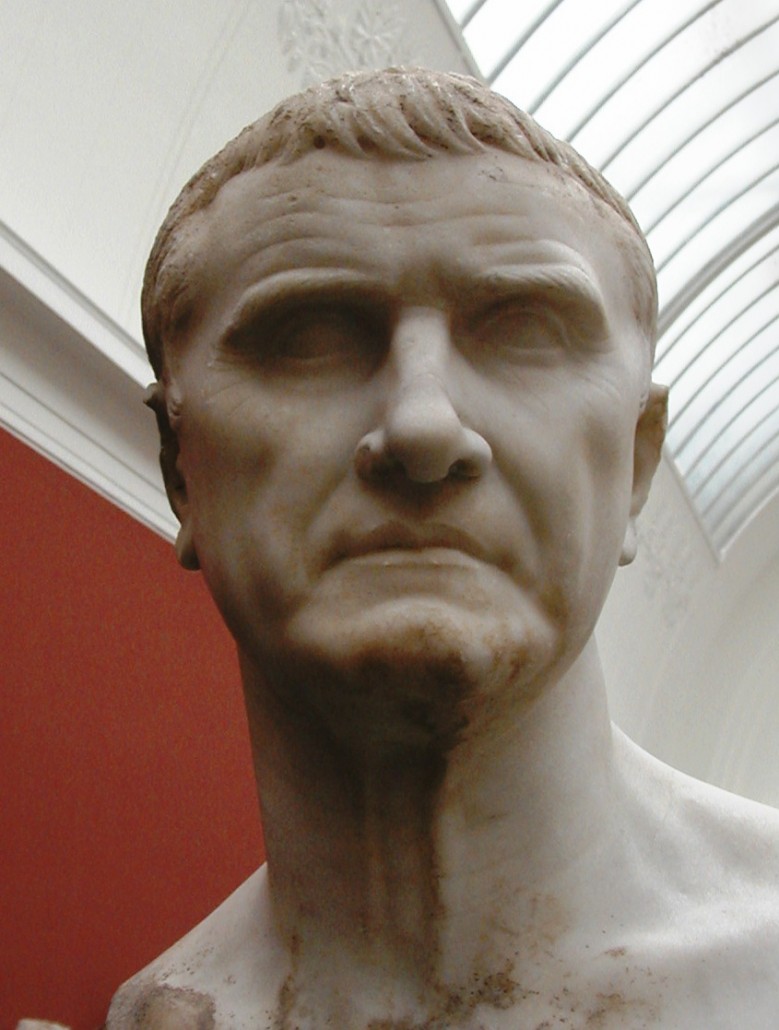 Roman statesman and general Marcus Licinius Crassus (c. 115 BC – 53 BCE) (Source: Photo by Diagram Lajard of Ancient.eu). Crassus’ dreams of becoming the new Alexander by conquering Parthian Persia were to be crushed by the cavalrymen of General Surena at Carrhae in 53 BCE.
Roman statesman and general Marcus Licinius Crassus (c. 115 BC – 53 BCE) (Source: Photo by Diagram Lajard of Ancient.eu). Crassus’ dreams of becoming the new Alexander by conquering Parthian Persia were to be crushed by the cavalrymen of General Surena at Carrhae in 53 BCE.
Even in Rome opinion was against such a campaign. Nevertheless, at the end of 55 B.C. Crassus marched off to Syria, where he arrived in the late spring of 54 B.C., and set out for Mesopotamia in the spring of 53 B.C.
At this time the Romans knew little about the Parthians and their army, which explains why Crassus “in addition to the campaign itself, which was the greatest mistake of all” (Plutarch, Crassus 17), made every other conceivable mistake. At the beginning of May, 53 B.C. Crassus and his Roman army fell into a trap set by the Parthians under their young commander Surena at Carrhae. Roughly one half of the Roman army of about 40,000 men, including Crassus and his son perished, 10,000 men were made captive, and only ten thousand were able to escape. (For details of this campaign, see N. C. Debevoise, A Political History of Parthia, Chicago, 1938, p. 78, n. 38, and E. Gabba in La Persia e il mondo greco-romano, Accademia Nazionale dei Lincei, Quaderno 76, Rome, 1966, pp. 51ff.).
This victory produced a mighty echo amongst the peoples of the East without however causing any decisive shift in the balance of power. (Cf. D. Timpe, “Die Bedeutung der Schlacht von Carrhae,” Museum Helveticum 19, 1962, pp. 104ff.) As for Surena, the victor of Carrhae, it soon cost him his life. Probably fearing that he would constitute a threat to himself, King Orodes II had him executed.
Parthian Horse archers engage the Roman legions of Marcus Lucinius Crassus at Carrhae in 53 BCE. Unlike the Achamenid-Greek wars where Achaemenid arrows were unable to penetrate Hellenic shields and armor, Parthian archery was now able to penetrate the armor and shields of their Roman opponents (Picture Source: Antony Karasulas & Angus McBride).
In the next few years the Parthians proved incapable of exploiting their victory, even when, after 50 B.C., the Romans were preoccupied with the conflicts between Pompey and Caesar and the subsequent civil war. Not until 41 B.C. or the start of 40 B.C. did the Parthians launch a major attack. Their army was led by Pacorus, son of Orodes, and the Roman, Quintus Labienus, who had been sent as an ambassador by Cassius, the Roman commander in chief in Syria, to conduct negotiations at the Parthian court and had remained there after the defeat of the republicans in the Roman civil war.
At the outset the Parthian attack was crowned with success: Labienus conquered large parts of Asia Minor, while Pacorus occupied Syria and Palestine. Soon, however, the situation changed. Mounting a counterattack in the year 39 B.C., the Romans defeated first Labienus and then Pacorus, who both lost their lives.
The death of his son Pacorus caused Orodes to appoint his eldest son Phraates IV (ca. 40-3/2) as successor. This was to prove a fatal error because Phraates murdered not only his father and brothers but also his own son and persecuted the nobility, many of whom left the country. The Romans under Antony saw an opportunity to attack the Parthians when the latter rejected a peace offer, coupled with a demand to hand back the Roman standards and captives taken at Carrhae, and Antony began the war in 36 B.C. According to Plutarch (Antonius 37.3) he marched with 100,000 men across Armenia to Media. But this campaign, too, was destined to fail. The Parthians inflicted a crushing defeat on the Roman rearguard, destroying the siege engines, while Antony, marching on ahead with the main body of his troops, started to besiege Phraata (Phraaspa), the exact location of which remains unknown. The widely-held suggestion that it is identical with Taḵt-e Solaymān to the southeast of Lake Urmia, where excavations have been carried out by the German Archeological Institute since 1959, is unproven (see K. Schippmann, Die iranischen Feuerheiligtümer, Berlin, 1971, pp. 309ff.; H. Bengtson, Zum Parther-Feldzug des Antonius, Munich, 1974). Because his Armenian auxiliaries had withdrawn and since the season was advancing and his supplies were running low, Antony had to break off the siege and embark on what proved to be a costly retreat. Plutarch (Antonius 50) puts the Roman losses at 24,000 men.
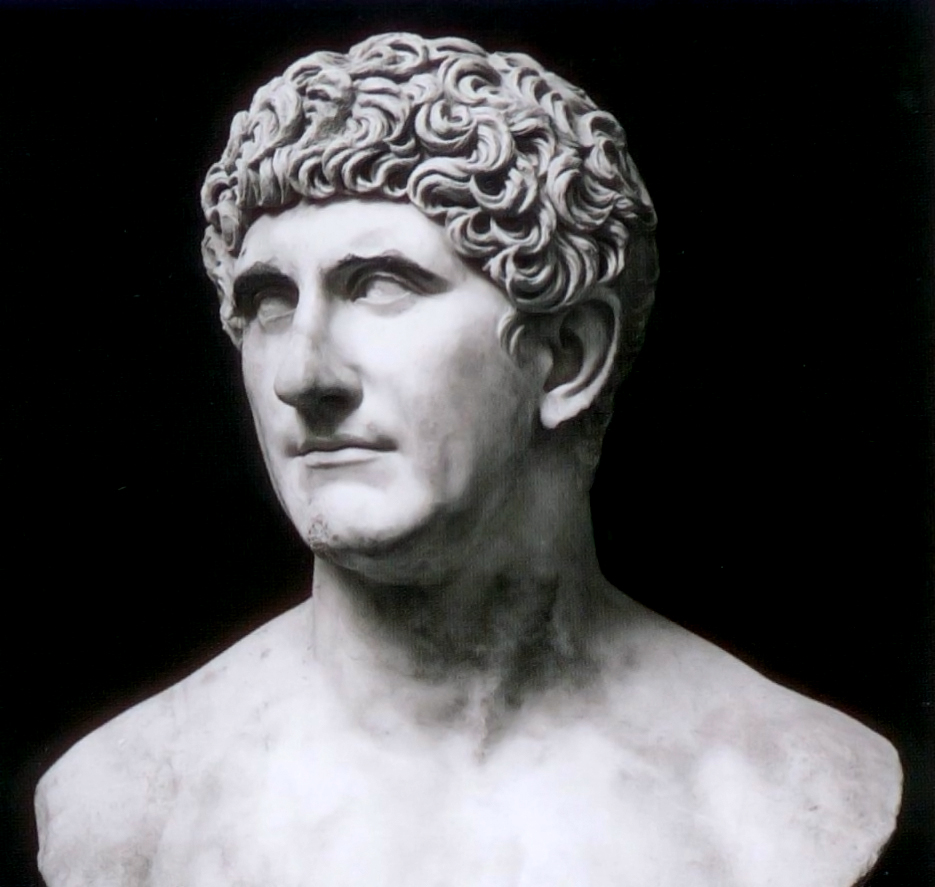 Marc Antony (83-30 BCE) Roman statesman and military leader (Source: Markantony.org). His expedition into ancient Praaspa (near modern Tabriz) ended in disaster in 36 BCE mainly at the hands of Iranian Parthian armoured knights and horse-archers. In one of the engagements, the Mede infantry destroyed 10,000 Roman legionnaires. Marc Antony and his surviving troops fled into Syria and from there to Egypt where Ptolemid Queen Cleopatra provided them sanctuary and shelter (For more details consult Farrokh, 2007, pp.144-146).
Marc Antony (83-30 BCE) Roman statesman and military leader (Source: Markantony.org). His expedition into ancient Praaspa (near modern Tabriz) ended in disaster in 36 BCE mainly at the hands of Iranian Parthian armoured knights and horse-archers. In one of the engagements, the Mede infantry destroyed 10,000 Roman legionnaires. Marc Antony and his surviving troops fled into Syria and from there to Egypt where Ptolemid Queen Cleopatra provided them sanctuary and shelter (For more details consult Farrokh, 2007, pp.144-146).
Like after Carrhae, however, the Parthians were unable to use this victory, because of a civil war which lasted from 32/1 B.C. to 25 B.C. A certain Tiridates revolted against Phraates IV, probably with the support of aristocratic circles and also, it seems likely, abetted by the Romans from time to time. After certain initial successes this rebellion failed, but the difficulties of the Parthian king were by no means at an end, as can be seen from the fact that his coinage ceased in about 24/3 B.C. Also, according to Josephus (Jewish Antiquities 16.253), Phraates had to contend with a further rival king by the name of Mithridates in the years 12-9 B.C.
For their part the Romans under Augustus exploited this difficult situation of the Parthian king. In 20 B.C. they sent an army against Armenia, then ruled by King Artaxes who was hostile to Rome. In the circumstances, Phraates felt obliged to comply with the frequently expressed demands of the Romans that the captives and standards of the legions seized at Carrhae and other standards taken from Decidius Saxa (40 B.C.) and Marc Antony (36 B.C.) should be returned. In Rome this act of restoration was celebrated as if a great victory had been won over the Parthians on the field of battle. In the context of these events both sides seem also to have concluded an informal peace treaty. (For details see K. H. Ziegler, Die Beziehungen zwischen Rom und dem Partherreich, 1964, Wiesbaden, pp. 48ff., Dabrowa, op. cit., pp. 91ff.) Rome recognized the Euphrates as a frontier whilst the Parthians on their side accepted Roman overlordship over Armenia. Now, however, the “personal” difficulties of Phraates IV really began. Augustus had sent the Parthian monarch a “Greek gift,” an Italian slave-girl called Musa. She rose to become his favorite wife and bore him a son named Phraataces, the later Phraates V. Hoping to obviate any problems over the succession, Phraates IV sent his four first-born sons to Rome where they would be protected by loyal hands, but Musa seized the opportunity to poison him, and her own son mounted the throne.
Soon afterwards conflict arose between Rome and Parthia over the question of Armenia. As a result the Romans appeared with a large force in Syria. Phraates gave way, and negotiations held in A.D. 1 ended with the Parthians relinquishing any claims to influence affairs in Armenia and the Romans granting recognition to Phraataces as a legitimate and sovereign ruler. Only a few years later, however, an uprising led to his being driven from the country (A.D. 4), and he died shortly afterwards in Syria. His successor, Orodes III, was murdered two years later in A.D. 6.
Reconstruction by Peter Wilcox and the late historical artist, Angus McBride of Parthian armoured knights as they would have appeared in 54 BCE (Picture Source: Osprey Publishing).
The Parthian nobility now turned to one of the sons of Phraates IV who had been sent to Rome. Augustus returned the eldest of them, Vonones, to Parthia where he was crowned king in 8/9. But life in Rome, in the opinion of the Parthians at least, had made Vonones “soft,” and they were unhappy about his tight budgetary control, so a rival candidate was set up by a section of the nobility. This was Artabanus who came from the northeast of Iran, probably Hyrcania. (For a comprehensive, specialist study see U. Kahrstedt, Artabanos III. und seine Erben, Bern, 1950.) When he first tried to seize power he was defeated by Vonones. Only at the second attempt was he successful, being crowned king in Ctesiphon in 10/11. Vonones withdrew to Armenia where he occupied the vacant throne for a short time, probably with Roman approval. However, when Artabanus threatened military action against him, the Romans withdrew their support from Vonones.
Encouraged by the Romans’ willingness to yield to him in this way, Artabanus now attempted to make his own son king of Armenia, but Rome was not prepared to accept this. Instead, the emperor Tiberius sent his adoptive son Germanicus to Armenia at the head of a large army, and he appointed a son of the king of Pontus as monarch there with the title Artaxes III. After this Artabanus gave way, with the result that about 18/19, amicable relations were apparently re-established on the pattern of the treaties concluded in 20 B.C. and 1 B.C. The main loser was Vonones who was deported to Cilicia by the Romans and died there in A.D. 19 when attempting to escape.
The following decade and a half was a period of peaceful coexistence for the two powers, and Artabanus profited from this to consolidate his own position within the Parthian empire. In Media Atropatene, Mesene-Characene, Persis, and Elymais the native dynasties were removed and replaced by Parthian secundogenitures. Only in the eastern part of the empire did Artabanus encounter difficulties. Here a dynasty of Parthian provincial rulers, frequently referred to as “Pahlawa,” held sway (probably the Surena family from eastern Iran; on the internal policy of Artabanus II see Dabrowa, op. cit., pp. 73ff.).
In A.D. 35 conflict with Rome was to break out again, and once more Armenia was the cause: King Artaxes had died without leaving an heir, and Artabanus moved to install his eldest son Arsaces on the throne. However, fearing that Artabanus was becoming too powerful, the nobility negotiated with the Romans against him: Emperor Tiberius then sent them Phraates, one of the four sons of Phraates IV, and when he died en route in Syria, Tiridates, a grandson of Phraates IV, was sent in his place. The Romans in addition appointed Mithridates, a brother of the ruler of Iberia, as king of Armenia. An Iberian army then conquered Armenia and beat off a counter-attack by the Parthians. With the backing of a Roman army commanded by L. Vitellius, the governor of Syria, Tiridates was crowned supreme king in Ctesiphon, and Artabanus withdrew to Hyrcania. However, Rome’s efforts to maintain “Roman” Parthians on the throne met with little success. Very quickly the Parthians became dissatisfied with Tiridates; indeed, before the year 36 was out, a section of the nobility was inviting Artabanus to take over the monarchy again. The Romans therefore arranged a meeting on the Euphrates between Vitellius and Artabanus in the spring of A.D. 37. The precise outcome of these negotiations is not known, but in all likelihood “status quo” was re-established: the Parthians agreed not to intervene in Armenia, and the Romans recognized the existing frontiers as well as Parthian sovereignty. (On the foreign policy of Artabanus, see Dabrowa, op. cit., pp. 103ff.)
However, the internal political problems of Artabanus were not over yet. Seleucia, one of the most important cities in the Parthian empire rose in rebellion from A.D. 36 to 42 perhaps due to a struggle between the indigenous and the Greek aristocracies (so R. H. McDowell, Coins from Seleucia on the Tigris, Ann Arbor, 1935, pp. 224ff.; but see also U. Kahrstedt, Artabanos III., pp. 25ff., 44ff.) or possibly because of a “class struggle” between rich and poor (thus N. Pigulevskaja, Les villes de l’état iranien aux époques parthes et sassanides, Paris, 1963, pp. 61ff., 85). Furthermore, Artabanus had to contend with a rival who enjoyed the support of the Parthian nobility, Cinnamus, one of his own foster sons. Eventually the ruler of Adiabene, Izates II, into whose kingdom Artabanus had withdrawn, managed to reconcile the two rivals. Artabanus probably died in A.D. 38 after a reign of some twenty-eight years.
Gotarzes II (c.43/44-51 CE) (Source: Classical Numismatic Group in Public Domain).
He was succeeded by his son Vardanes I (ca. 39-ca. 45, thus Le Rider, MDAFI, 1965, p. 461, who does not rule out the possibility that Vardanes reigned until 47/8, see p. 426 n. 1; Kahrstedt, Artabanos III., pp. 24ff. et alibi; R. Hanslik, Pauly-Wissowa, VIII/A, 1, 1955, col. 369, and others name Gotarzes as direct successor). A rival monarch, Gotarzes II, (43/4-51), a nephew of Artabanus caused several years of conflicts which ended with the murder of Vardanes.
Dissatisfied with Gotarzes, the Parthians requested the return of a rival, Meherdates, son of Vonones, who lived in Rome. In A.D. 49, however, Gotarzes managed to win a decisive victory over his new rival in Kurdistan. A famous bas-relief on the rock at Bīsotūn may refer to this event. (Thus E. Herzfeld, Am Tor von Asien, p. 46, and others, who take the view that the Gotarzes mentioned in the accompanying inscription is identical with Gotarzes II, whereas M. L. Chaumont, Syria 48, 1971, pp. 156f. argues against their identity.) The joys of victory were, however, short-lived since Gotarzes died in A.D. 51.
It is not clear whether a certain Vonones, brother of Artabanus II and king of Armenia now took over the reins of power, to be followed by his son Vologases, or whether the latter succeeded directly. Certainly, Vologases I (ca. 51-77/9) reigned for a long time by Parthian standards; even though he too had to come to terms with a series of political problems at home and abroad.
In A.D. 53 Vologases succeeded in appointing his brother Tiridates king of Armenia after King Mithridates had been murdered. At first the Romans were unable to do much about the situation because of the poor condition of their forces in the region, and merely wrote to Vologases, recommending him to make peace and to give hostages.
In 58, however, the Romans proceeded to attack. They enjoyed some initial success, but in the winter of 62 Vologases managed to surround a Roman army near Rhandeia (on the Arsanias, a tributary of the Euphrates) and force it to capitulate. After negotiations, the Parthian lifted their siege and the Romans withdrew from Armenia, leaving Vologases to apply directly to Rome to have Tiridates invested with the Armenian crown in fief (on the relations between Parthia and Rome from 63 to 79, see Dabrowa, op. cit., pp. 154ff.). In A.D. 66 Tiridates traveled to Rome, where he received the crown of Armenia from the hands of the emperor Nero himself (see Dio Cassius 53.5, 2). The two empires then co-existed peacefully for a few decades.
Statue of Tiridates I, founder of the Arsacid dynasty of Armenia, at the Parc et jardins du château de Versailles (Source: Eupator for Public Domain). Tiridates, a Zoroastrian priest, was to travel with the magi to Rome in 66 CE to symbolically receive his crown from Emperor Nero (r. 54-68 CE). This was part of a political solution to resolve the Parthian-Roman conflict over Armenia. In practice however, the Armenian question between Rome and Iran was to remain well into the Sassanian era.
Vologases died in A.D. 80 or perhaps earlier if certain coins are to be ascribed to him (see R. H. McDowell, op. cit., pp. 119ff., 230, but also Le Rider, MDAFI, London, 1965, pp. 174f. and G. D. Sellwood, An Introduction to the Coinage of Parthia, 1971, p. 220). Parthian history in the next few decades is difficult to reconstruct. Various pretenders to the throne, Pacorus II, Vologases II, and Osroes must have held sway over fairly large territories within the Parthian empire. In view of the apparently very long reign of Vologases II (A.D. 77/8-146/7), Le Rider, op. cit., introduced a further king, to whom he ascribed the coinage of the years 77/78, 89/90, and 106/08; the ruler referred to as Vologases II thus becomes Vologases III; according to Le Rider’s account, he ruled from A.D. 111/12 (see also E. J. Keall, JAOS 95, 1975, p. 630 n. 36). At any rate, after the internal conflicts came to an end (from 114) Osroes probably occupied the Parthian throne; he was the adversary of the Romans in the Parthian war begun in 114 under the emperor Trajan. The precise reasons for this war are unknown. Economic factors may have played a part, such as the desire to gain control of the trade routes through Mesopotamia (thus J. Guey, Essai sur la guerre parthique de Trajan, Bucharest, 1937, or military aims such as the attainment of a secure frontier by annexing Armenia and northern Mesopotamia (thus F. A. Lepper, Trajan’s Parthian Way, London, 1948, or simply the pursuit of personal glory on the emperor’s part (thus Dio Cassius 68.17.1). It may well be, however, that all three reasons played a part.
In 114 the Romans marched into Armenia, killing Parthamasiris whom Osroes had installed as king there. From there Trajan conquered northern Mesopotamia (by the end of 115) and shortly afterwards the Parthian capital Ctesiphon. The Romans even managed to advance as far as the Persian Gulf, but then the reverses began. Trajan was in Babylon on the march back when he heard that a rebellion had broken out in many parts of the territory he had conquered. In addition, a revolt by the Jews had begun in Cyrenaica and was spreading throughout the Levant as far as Egypt. In the end the Romans once again proved masters of the situation, but not without suffering losses, both materially and in terms of prestige. Trajan also profited from power struggles within Parthia itself, but ultimately his victory cost too much. The Parthian Great King still had sufficient military forces at his disposal, and Trajan’s attempt to conquer Hatra, one of the main Parthian bulwarks in northern Mesopotamia, ended in failure. Before he could contemplate a new campaign Trajan died in the summer of A.D. 117.
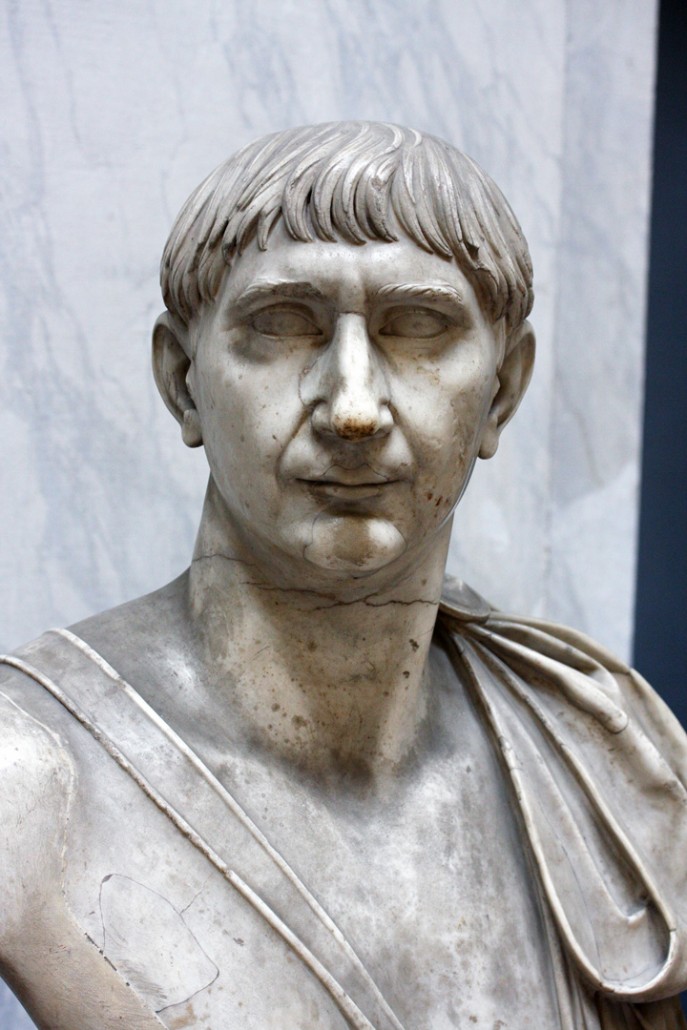 Bust of Emperor Trajan (r. 98-117 CE) housed in the Vatican Museums (inv. 2269) (Source: Trajans Column).
Bust of Emperor Trajan (r. 98-117 CE) housed in the Vatican Museums (inv. 2269) (Source: Trajans Column).
Trajan’s successor Hadrian recognized only too clearly that apart from a few spectacular but momentary successes, such as the capture of Ctesiphon and the advance to the Persian gulf, Trajan’s campaign had produced little of value for Rome. Thus more peaceful times returned. The Euphrates once again became the frontier and Rome relinquished Armenia, Mesopotamia, and Assyria, a province re-established by Trajan, which corresponded roughly to the territory of ancient Babylonia. No doubt the peace must have been welcome to both sides.
Osroes, however, had conflicts with his rival Vologases III, which must have ended in victory for Vologases after 129 since Osroes’ coinage ceased to appear in Seleucia in 127/8.
Vologases III (after 129-146/8), too, had to contend with a rival king: Mithridates IV, who met with little success. Probably more dangerous were the Alans who between 134 and 136 attacked Albania, Media, and Armenia, penetrating as far as Cappadocia. The only way Vologases was able to persuade them to withdraw was probably by paying them. The Romans, too, under Hadrian’s successor Antoninus Pius (138-161), were active, installing a new king in Armenia. The Parthians did not react possibly because their forces were inadequate or in order to preserve peace and the flourishing, highly profitable caravan trade that came with it.
Peaceful conditions also prevailed in the early part of the reign of Vologases IV (147/8-190/1 or 192/3). On the death of Antoninus Pius, the Parthians reopened hostilities and gained some successes against Marcus Aurelius: they conquered Armenia, installing a new king named Pacorus, and also marched into Syria. But a Roman counter-offensive in 163 won back Armenia, where a new ruler by the name of Sohaemus was crowned king by the grace of Rome, and in 164 they forced the Parthians to give up Syria, and their general Avidius Cassius began to march into Mesopotamia. At the end of 165 or the beginning of 166 the Romans took Seleucia and Ctesiphon, but once again the Parthians were fortunate: an epidemic, probably of small pox, broke out forcing the Romans to retreat in the spring of A.D. 166. In the process they suffered heavy losses.
For the next three decades peace reigned, partly perhaps because various Roman emperors struggled for power. Finally Septimius Severus gained the upper hand, and began a new war against the Parthians, who by this time were ruled by Vologases V (190/1 or 193-208/09). This war lasted from 195 to 199, but although Seleucia and Ctesiphon again fell to the Romans, and Hatra was besieged, shortage of food and supplies forced Septimius Severus and his army to withdraw. Still, the Romans had managed this time to secure their frontier against Parthia by creating two new provinces, Osrhoene and Mesopotamia. According to some recent investigations (see M. G. A. Bertinelli, in Temporini and Haase, op. cit., II, 9/1, pp. 41ff.) the southeastern frontier ran from Alaina (Tell Ḥayal) via Singara (Beled Sinǰar) further east via Zagurae (ʿAin Sinu) to Vicat (Tell ʿIbra) and possibly up to the Tigris (Mosul).
After 207/8 Vologases VI followed his father on the throne, but soon (ca. 213) had to fight his younger brother Artabanus IV. In the year 216 the emperor Caracalla asked Artabanus IV for the hand of his daughter in marriage, in itself a clear evidence of the fact that the latter was then monarch, even though the coinage of Vologases VI continued to appear in Seleucia until at least 221/2.
Artabanus turned down Caracalla’s request, thus giving the Roman emperor a pretext for a new Parthian war. Although Caracalla and his army succeeded in advancing as far as Arbela, the capital of Adiabene, he does not appear to have achieved any decisive victory over the Parthians.
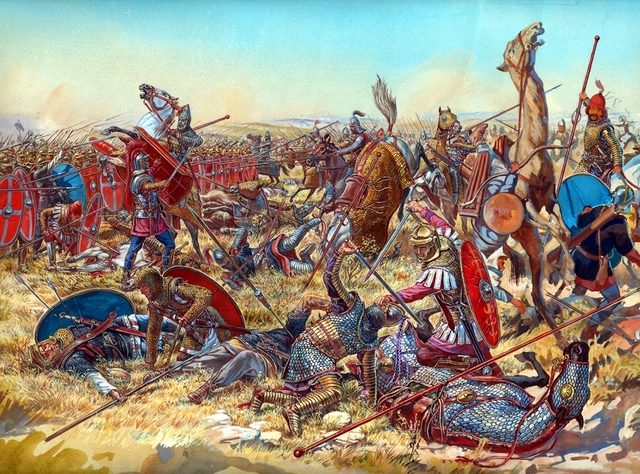 The three-day Battle of Nisibis (summer 217 ) fought between Roman emperor Macrinus and the Parthian army of King Artabanus IV (Source: Fall3nairborne.Deviantart,com for Pinterest). Macrinus failed to defeat the Parthians, obliging him to negotiate a peace settlement by paying them fifty million Dinars as well as gifts. This also signaled the end of Caracalla’s attempted invasion of Mesopotamia the previous year.
The three-day Battle of Nisibis (summer 217 ) fought between Roman emperor Macrinus and the Parthian army of King Artabanus IV (Source: Fall3nairborne.Deviantart,com for Pinterest). Macrinus failed to defeat the Parthians, obliging him to negotiate a peace settlement by paying them fifty million Dinars as well as gifts. This also signaled the end of Caracalla’s attempted invasion of Mesopotamia the previous year.
In April 217 the Parthians mounted a fairly big offensive to avenge Caracalla’s action, demanding from his successor, Macrinus, the withdrawal of the Romans from Mesopotamia and restitution for the damage they had caused. Macrinus was neither able nor willing to agree to these demands, so the war continued and the Romans were defeated at Nisibis, as suggested by the terms of the peace treaty: The Romans paid the Parthian king and the nobility a total of fifty million dinars in cash and gifts at the beginning of A.D. 218.
The peace brought little advantage to Macrinus and his successors, Elagabal (218-222) and Severus Alexander (222-35), since the Parthian era now came to an end.
It was Ardašīr (q.v.), a minor Parthian vassal in Persis, who was to bring about the demise of the Parthian empire. From roughly A.D. 220 onwards he began to subjugate nearby territories and others further afield, such as Kermān. (For details of these events, see G. Widengren in La Persia nel Medioevo, Accademia Nazionale dei Lincei, Quaderno 160, Rome, 1971, pp. 711ff.) When Artabanus IV proceeded to take counter-measures it was too late. The decisive battle, probably on 28 April 224 in the region of what is now Golpāyegān, between Isfahan and Nehāvand (see Widengren, op. cit., p. 743-44), cost the Parthian Great King his life and in practice meant the end of the Parthian empire, even though Ardašīr only had himself crowned “King of Kings” some years later, probably in A.D. 226. At all events it can be assumed that the Sasanian dynasty, so named after an ancestor of Ardašīr, possibly his grandfather Sāsān, already exercised power throughout the Parthian empire before the year A.D. 230.
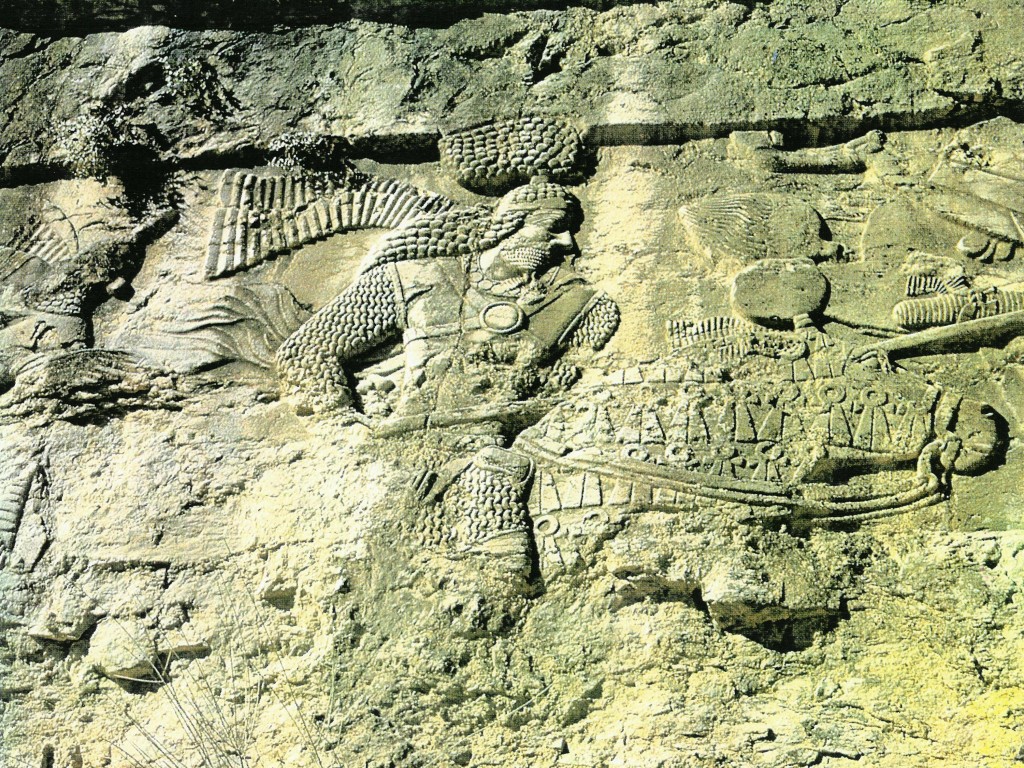 Ardashir I (r. 224-242 CE) in a lance-joust scene at Firuzabad which commemorates the great battle in which the House of Sassan overthrew the Parthians in 224 CE (Picture source: Photo taken by Farrokh in August 2001 and shown in Kaveh Farrokh’s lectures at The University of British Columbia’s Continuing Studies Division, Stanford University’s WAIS 2006 Critical World Problems Conference Presentations on July 30-31, 2006).
Ardashir I (r. 224-242 CE) in a lance-joust scene at Firuzabad which commemorates the great battle in which the House of Sassan overthrew the Parthians in 224 CE (Picture source: Photo taken by Farrokh in August 2001 and shown in Kaveh Farrokh’s lectures at The University of British Columbia’s Continuing Studies Division, Stanford University’s WAIS 2006 Critical World Problems Conference Presentations on July 30-31, 2006).
Résumé
The Parthian empire remained in existence for roughly 475 years and constituted, even during its periodic weak phases, the most significant power factor in the ancient East alongside the Romans. Though even today the Parthians are frequently classified as “barbarians” (thus, for instance, A. R. Bellinger, “The End of the Seleucids,” Transactions of the Connecticut Academy of Arts and Sciences 38, 1949, p. 75) or as “princes on horseback” for whom the conquering of Iran and Mesopotamia meant nothing more than new grazing grounds or feudal tenure, and who, unlike the Achaemenids and Sasanians, had no great political aim in mind, this is a view which is no longer tenable. The Parthians have every right to be considered on a par with the Seleucid and Sasanian dynasties not only politically but also culturally. One must also not view Parthian history solely in terms of the struggles against the Seleucids and the Romans, for the Parthian empire was not only aligned against the West, but also occupied a position between the Greco-Roman world to the west and that of Central Asia to the east.
There is also ample evidence to show that the Parthians felt themselves to be the heirs of the Achaemenids. Thus, for example, they adopted the Achaemenid title “King of Kings” on their coinage. The figure of the seated archer that appears very early on the reverse of their coins also derives from the Achaemenids, for whom the bow, as depicted on coins, seals, and reliefs, symbolized royalty (see R. Ghirshman, in Temporini and Haase, op. cit., II, 9/1, 1976, p. 215). In addition, Tacitus (Annals 6.31) records that the envoys of Artabanus II demanded from the Romans the return of all the territories that had once belonged to the Achaemenids (for a detailed account, see J. Wolski, in Temporini and Haase, op. cit. II, 9/1, 1976, pp. 204f.).
 Partho-Sassanian belt buckle dated to the 2nd or 3rd century CE (Picture source: Farrokh, page 143,Shadows in the Desert: Ancient Persia at War-Персы: Армия великих царей-سایههای صحرا–).
Partho-Sassanian belt buckle dated to the 2nd or 3rd century CE (Picture source: Farrokh, page 143,Shadows in the Desert: Ancient Persia at War-Персы: Армия великих царей-سایههای صحرا–).
On the basis of details like these and others, J. Neusner (Iranica Antiqua 3, 1963, pp. 40ff.) and Wolski have arrived at the opinion that the Arsacids had a political idea, central to which was a commitment to Iran as a national concept. The somewhat disparaging term “Philhellenes,” which even today is sometimes used to characterize the Parthians, was no doubt justified to a certain extent, given the very poor state of findings and historical research in the early days.
However, quite aside from the fact that new findings have now established Iranian elements also in the art of the period, it is possible that the Parthian kings deliberately used the designation “Philhellene” on their coinage as a political device to make it easier for them to ensure the cooperation of the Greeks in their empire, especially in Mesopotamia.
One question remains to be answered: What were the reasons for the downfall of such an important empire or, more precisely, how did a minor Parthian vassal contrive to bring about its destruction? No doubt there were several reasons. One was the latent antagonism between the monarch and the nobility or even, as was frequently the case, the dependence of the ruler on this group. Another important reason was the fact that the Parthian empire often fought or frequently had to fight wars on two fronts, for in addition to the Seleucids and Romans in the west they had great adversaries in the east, such as the Greco-Bactrians, the Kushans who succeeded them, the Sakas, the Alans and other peoples of Central Asia. In the long run these conflicts overtaxed both the military and the economic strength of the Parthian empire (see also Dabrowa, op. cit., pp. 174f.).
Parthian society from the third century B.C. to the third century A.D.
As a result of archeological research, particularly the work carried out by the Russians in Turkmenistan and Chorasmia, it must now be accepted that political entities of some considerable size existed in Parthia and Margiane, i.e. in the territory of the present-day SSR Turkmenistan, as early as the first millennium B.C. and not just from the times of the Achaemenids or the Seleucids (see V. M. Masson and V. I. Sarianidi, Central Asia, London, 1972, pp. 155ff.). The existence of fairly large towns can also be assumed, such as Samarkand, Marv, Elken Tepe, and Yaz Tepe, to name only a few. For the most part, however, there were villages of varying sizes, and large irrigation systems played a significant role (Polybius 10.28, pp. 3ff., Justin 41.5.4). Life in southern Turkmenistan was dominated by big landowners who had large numbers of serfs at their disposal. Beyond this there was certainly a considerable number of slaves, although village communities with free peasants also existed.
A reconstruction of the face on the statue of a Parthian nobleman housed at Tehran’s Iran Bastan Museum (Picture Source: Parthian Empire).
Such were the prevailing conditions when the Parni arrived. To label the latter simply as nomads from the steppes would be injudicious. Soviet Russian excavations in the territories adjacent to southern Turkmenistan, such as Chorasmia, have demonstrated that in the sixth and fifth centuries B.C. the area was inhabited by the so-called “Massagetae Federation,” an association of different tribes who lived a sedentary life, raising cattle and tilling the land (for details, see S. P. Tolstov, Auf den Spuren der altchoresmischen Kultur, Berlin, 1953, pp. 101ff.). After the Parni chieftain had been crowned king in Asaak, conditions must have changed, for now he had to rule not only over the Parni but also over the inhabitants of the conquered territory, who were predominantly Parthians. In other words, he had to try to strengthen his position. (J. Wolski estimated that despotism was established as early as the first half of the second century B.C., cf. Deutsche Historiker-Gesellschaft, Neue Beiträge zur Geschichte der Alten Welt, ed. E. Weiskopf, I, Berlin, 1964, pp. 379ff.).
It is reasonable to assume that a further change in the social structure of the empire took place from the time of Mithridates I (ca. 171 to 139/8 B.C.). Then and in the following period the Parthian empire increased enormously in size, especially as a result of the conquest of Mesopotamia, so that it now had large Hellenistic cities such as Seleucia, Dura-Europos, and Susa. The rulers now had to administer and direct the affairs of an empire of world status, which must frequently have made it necessary for them to disregard old tribal traditions. One instance of this was the accession of Mithridates I. It was customary for the eldest son to succeed to the throne, but in this case Phraates I passed over his numerous sons and appointed as king his brother Mithridates. The execution of Surena, the victor at Carrhae shows the relatively unlimited power of the supreme monarch in Parthia.
In this period the nobility must also have extended its power and influence considerably, not least as a result of the vast estates it acquired in the course of the various conquests (J. Wolski, “L’aristocratie foncière et l’organisation de l’armée parthe,” Klio 63, 1981, pp. 105ff.).
Historians differ in their judgment as to whether it is legitimate to talk of a feudal system at this epoch in Parthian history. The view that such a state of feudalism did exist is taken by Widengren (Temporini and Haase, op. cit., II, 9/1, 1976, pp. 249ff.) and others (for example N. C. Debevoise, Political History, p. xlii, and E. Herzfeld, AMI 4, 1932, p. 54). In my opinion, however, Parthian history falls into different stages of development, and it is therefore impossible simply to refer to the state of Parthia as a single feudal state (thus also K. H. Ziegler, Beziehungen zwischen Rom und dem Partherreich, Wiesbaden, 1964, pp. 16f.; F. Altheim and R. Stiehl, Geschichte Mittelasiens, Berlin, 1970, p. 528). Thus we know little about Parthian history from the beginnings until into the first century B.C., and what information we have about the subsequent period derives predominantly from the western part of the empire, i.e. Mesopotamia.
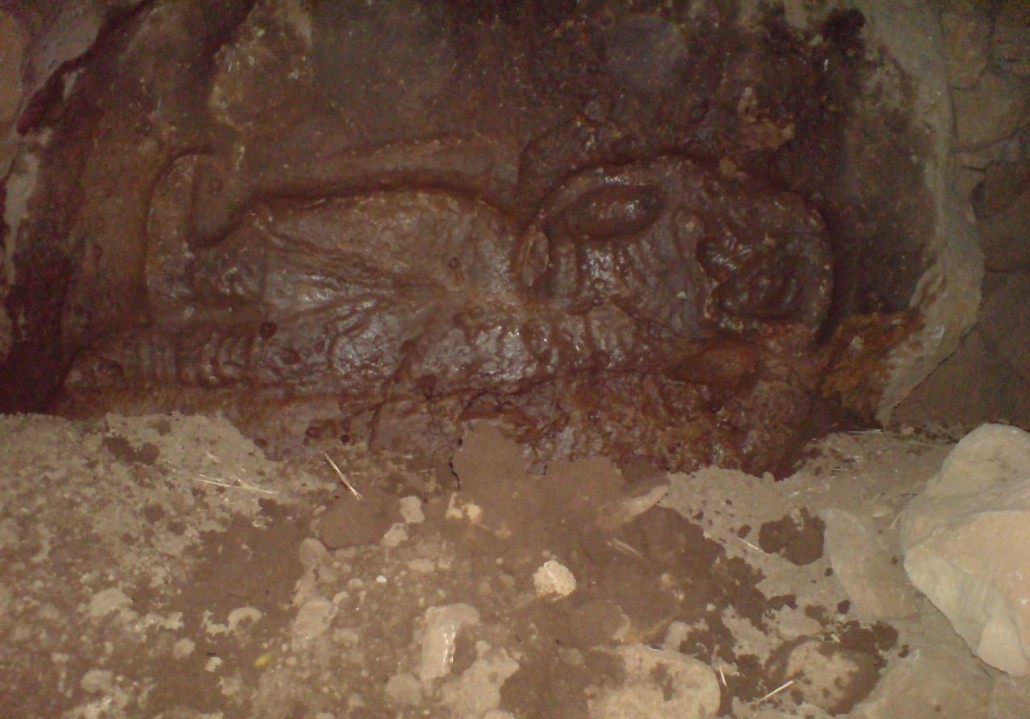 The Parthian relief at Andika discovered by Dr. Gholamreza Karamian and Farzad Astaraki. The specific location of this relief is in the northern village of Darvish Ahmad that is 50 kilometers from western Andika in Khuzestan Province. The GPS position of the site is: N 32 23 32/3 and E 49 30 21/5. The dimensions of the Andika relief are 2 meters (length) by 1.20 meters (width) (Courtesy of Dr. Gholamreza Karamian and Farzad Astaraki). For more on the findings of the Karamian-Astaraki team see here…
The Parthian relief at Andika discovered by Dr. Gholamreza Karamian and Farzad Astaraki. The specific location of this relief is in the northern village of Darvish Ahmad that is 50 kilometers from western Andika in Khuzestan Province. The GPS position of the site is: N 32 23 32/3 and E 49 30 21/5. The dimensions of the Andika relief are 2 meters (length) by 1.20 meters (width) (Courtesy of Dr. Gholamreza Karamian and Farzad Astaraki). For more on the findings of the Karamian-Astaraki team see here…
Soviet-Russian historians, who define the concept of feudalism quite differently by focusing attention on the conditions of production (see B. F. Porschnew, Sowjetwissenschaft, Gesellschaftswissenschaftliche Abteilung 1, 1954, pp. 75ff., 84), view the system as one of slave ownership. According to their interpretation, the existence of a feudal system can not be assumed before the subsequent Sasanian era (thus, for instance, N. Pigulevskaja, Les villes de l’état iranien, p. 136 and A. Perikhanjan, VDI, 1952, pp. 14ff.).
Economic life in the Parthian Empire
Agriculture undoubtedly played the most important role in Parthian economy, but few details are known about it. The same applies to handicraft. Our best information concerns trade. Numerous routes existed for the traffic of goods between East and West, not only the Silk Road. Although trading of some kind must surely have been carried on beforehand, it only began on a significant level in connection with the sending of an embassy by the Chinese to the court of Mithridates II. 114 B.C. is the first known date on which a caravan traveled from China to the west (thus A. Herrmann, Das Land der Seide und Tibet im Licht der Antike, Leipzig, 1938, p. 4 [repr. Amsterdam, 1968]). Isodorus of Charax has supplied us with some sort of survey of the routes in his Parthian Stations, written around the beginning of the Christian era. From Antiochia on the Orontes various routes led via Dura-Europos or across the Syrian desert via Palmyra to Seleucia, Ctesiphon, and Vologasia. (For details of the last named town, the location of which is still not identified exactly, see A. Maricq, Syria 36, 1959, pp. 264ff.; Chaumont, Syria 51, 1974, pp. 77ff., and G. A. Koshelenko, Studi in onore di Edoardo Volterra I, Milan, 1971, pp.761ff.)
From there the route led across the Zagros mountains to Kermānšāh and Hamadān, then on to Marv (Antiochia Margiana). Here it divided, one branch leading via Bukhara and Ferghana past the Issyk Kul into Mongolia, the other, more important one going to Bactria, then on to the “Stone Tower” (probably identical with Tashkurgan or with Darautkurgan in the Alai valley (Kirghizia), where Chinese traders took over the merchandise.
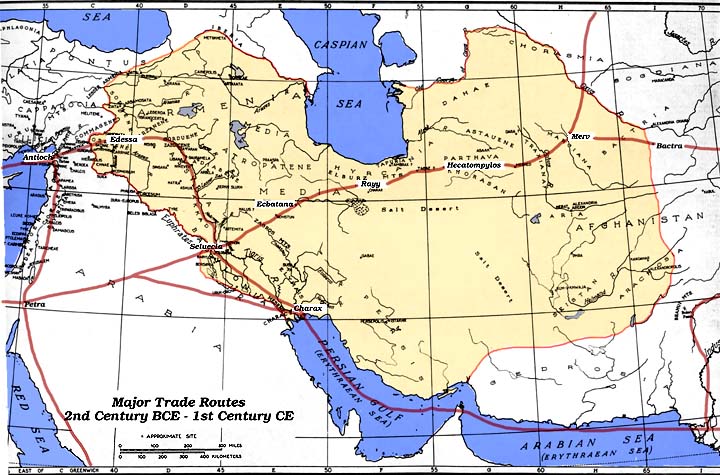 Map showing the trade routers of the Parthian Empire from the 2nd century BCE to the 1st century CE (Source: Americanhistory.si.edu).
Map showing the trade routers of the Parthian Empire from the 2nd century BCE to the 1st century CE (Source: Americanhistory.si.edu).
Maritime trade also deserves to be mentioned. The most important port was Charax Spasinu on the Persian Gulf, from where merchandise was shipped to India or sent overland to Seleucia. Besides, the Euphrates with its ramified system of canals played an important part in the trade of Mesopotamia. Here the Parthians acted primarily as middlemen, making their profits from the numerous customs posts they set up and from the various taxes they levied on goods in transit. The well known “Palmyrenian Tariff,” an extensive inscription in Palmyra of the year 137, provides us with an example of these taxes and also of the sorts of merchandise bought and sold at the time. With regard to economic conditions in the Parthian heartlands the ostraca from Nisa are now beginning to yield a certain amount of information (see I. M. Diakonov, M. M Diakonov, and V. A. Livshits, Sowjetwissenschaft, Gesellschaftswissenschaftliche Abt. 4, 1954, pp. 557ff.).
The army in the Parthian Empire
Unfortunately there is no comprehensive account of the Parthian army. The numerical size of the Parthian army can only be estimated approximately. At the battle of Carrhae: 10,000 cavalry are said to have taken part on the Parthian side (see Plutarch, Crassus 17; Dio Cassius 41.12) and in the struggle against Mark Antony in 36 B.C. their cavalry reportedly numbered as many as 50,000 (Justin 41.2.6). Probably the latter figure represented their maximum strength.
The most important types of forces in the Parthian army were the lightly armed cavalry equipped with bows and arrows and the so-called cataphracts, cavalrymen who were both heavily armed and heavily armored so that both horse and rider were protected by coats of chain mail. Their weapon was the lance or sometimes also the bow. It is not clear whether the terms clibanarii and catafracti were used to designate different kinds of armored cavalry, armed respectively with the lance and the bow (thus R. N. Frye, Persien, Essen, 1975, p. 391), or whether they are merely different terms for one and the same type of force (thus E. Gabba, op. cit., p. 65, n. 66).
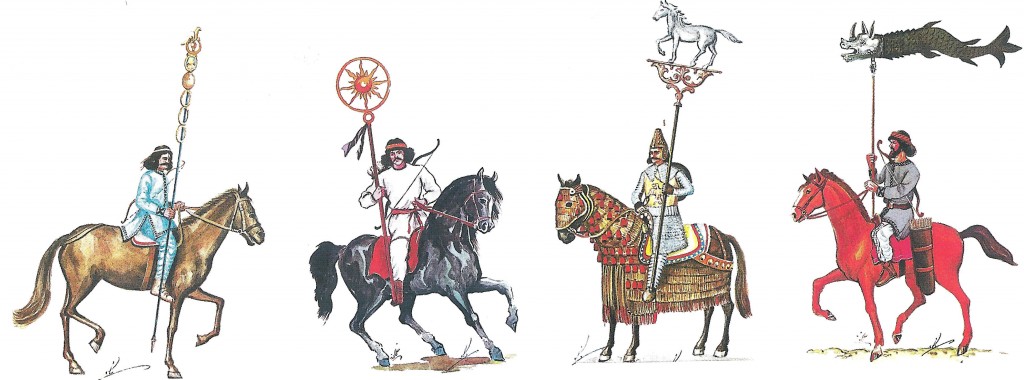 Parthian cavalry and banners (Picture source: Farrokh, page 130, Shadows in the Desert: Ancient Persia at War-Персы: Армия великих царей-سایههای صحرا– these drawings originally appeared by Zoka in the 2,500 Year Celebrations of the Persian Empire in 1971).
Parthian cavalry and banners (Picture source: Farrokh, page 130, Shadows in the Desert: Ancient Persia at War-Персы: Армия великих царей-سایههای صحرا– these drawings originally appeared by Zoka in the 2,500 Year Celebrations of the Persian Empire in 1971).
The social composition of the armed forces is unclear. Justin (41.2.6) claims that of the 50,000-strong army that fought against Mark Antony 4,000 were “freemen,” by which it is likely that he means nobles. Plutarch (Crassus 21) reports that at the battle of Carrhae the army was composed partly of pelátai (serfs) and partly of doûloi (retainers), but the precise distinction between the two is a matter of dispute. (See G. Widengren in Temporini and Haase, op. cit., II, 9/1, 1976, p. 282, nn. 336, 252; J. Wolski, Iranica Antiqua 7, 1967, pp. 141; Altheim and Stiehl, Geschichte Mithelasiens, p. 464, on the other hand, translate doûloi [servi] as “slaves” as do Pigulevskaja, Les villes de l’état iranien, pp. 81ff., and Wolski, “Les relations de Justin et de Plutarque sur les esclaves et la population dépendante dans l’empire Parthe,” Iranica Antiqua 18, 1938, pp. 148ff.). Finally, mention must be made of the mercenaries in the Parthian army, although historians differ in assessing their significance (see Widengren, op. cit., pp. 285ff. and Wolski, Iranica Antiqua 5, 1965, pp. 103ff.). [See also ARMY i.]
Bibliography
See also for Parthian history: W. W. Tarn, “Parthia,” in CAH2 X, pp. 574-613 (especially the bibliography pp. 946ff.).
J. Wolski, “The Decay of the Iranian Empire of the Seleucids and the Chronology of the Parthian Beginnings,” Berytus 12, 1956-58, pp. 35-52.
M. A. R. Colledge, The Parthians, Nijmegen, 1967.
Archeology: G. A. Pugachenkova, Puti razvitiya arkhitektury Yuzhnogo Turkmenistana pory rabovladeniya i feodalizma (The development of architecture in Southern Turkmenistan during the periods of slavery and feudalism), Yuzhno-Turkmenskaya Arkheologicheskaya Kompleksnaya Ekspeditsiya VI, Moscow, 1958.
G. A. Koshelenko, Kul’tura Parfii, Moscow, 1966 (detailed review by G. Glaesser in East and West 17, 1967, pp. 148-51).
M. Oppermann, “Beiträge zur parthischen Festungs- und Sakralarchitektur,” Wissenschaftliche Zeitschrift der Universität Halle 17, 1968, G, pt. 6, pp. 43-115.
G. Frumkin, “Archaeology in Soviet Central Asia,” in HO 7, 2/1, Leiden, 1970 (especially the section on “The Parthians”).
T. N. Zadneprovskaya, “Bibliographie de travaux soviétiques sur les Parthes,” Studia Iranica 4, pp. 243-60.
L. Vanden Berghe, Bibliographie analytique de l’archéologie de l’Iran ancien, Leiden, 1979 (especially pp. 256-71).
Idem and E. Haerinck, Bibliographie analytique de l’archéologie de l’Iran ancien. Supplement l. 1978-80, Leiden, 1981.
Arts: D. Schlumberger, Der hellenisierte Orient, Baden-Baden, 1969.
M. A. R. Colledge, Parthian Art, London, 1977.
G. A. Koshelenko, Rodina parfyan (The homeland of the Parthians), Moscow, 1977 (detailed review by P. Bernard in Studia Iranica 8, pp. 119-39).
Economy: M. Rostovtzeff, Social and Economic History of the Hellenistic World, 3 vols., Oxford, 1948.
H. Kreissig, Wirtschaft und Seleukidenreich, Schriften zur Geschichte und Kultur der Antike 16, 1978.
The following chapters in Camb. Hist. Iran III, Cambridge, 1983, deal with the Arsacids and contain extensive bibliographies: A. D. H. Bivar, “The Political History of Iran under the Arsacids,” III/I, pp. 21-101; D. Sellwood, “Parthian Coins,” III/I, pp. 279-98; O. Kurz, “Cultural Relations between Parthia and Rome,” III/2, pp. 681ff.; D. Schlumberger, “Parthian Art,” III/2, pp. 1027-54; M. Boyce, “Parthian Writings and Literature,” III/2, pp. 1151-65.

